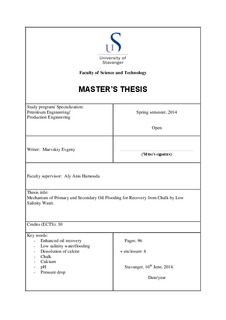| dc.description.abstract | This research work is performed with the intention to bring the contribution in the ongoing discussion of implementing the low salinity brines as the injection fluid in carbonate reservoirs. The work contains theoretical review of the materials connected to the topic, experimental part, interpretation of acquired data, discussion of results, simulation and proposed mechanism.
In this thesis the effect of changing the injection water salinity on oil recovery was studied. The porous media is represented by the Stevns Klint chalk cores. Synthetic oil that was used is the mixture of n-decane and stearic acid. Synthetic sea water was acquired by diluting salts in distilled water (total salinity is 33388 ppm). Low salinity brines represent the dilution of synthetic sea water 5 times, 10 times, 15 times, 20 times and 25 times.
Synthetic sea water and low salinity brines were studied during primary recovery water flooding on 4 PV/day flowrate and 16 PV/day flowrate. The recovery using different salinity gave different results both on low flowrate and on high flowrate. The data acquired during the flooding process, including pressure drop, pH of the effluent and the injection fluid, ions chromatography analysis, were interpreted and support the discussion about the observed recovery results. Based on these data the mechanism of the recovery increase with low salinity is proposed. It includes the brine/rock interaction which induces the dissolution of calcite. The dissolution leads to peeling off calcite particles and fine migration in core. Fines then block the pore throats and this increases the sweep efficiency. The proposed reason for the difference in dissolution rates between different salinity brines lies in physical properties of these brines, such as pH of injection fluid and IFT. The pH of brine decreases with lowering of salinity, which enhance the dissolution process. However, IFT between the injection fluid and synthetic oil increases with lowering of salinity, which increases the amount of capillary trapped oil. These two parameters working together can give the distribution of results as it was observed. The simulation of relative permeability curves in Sendra supports the proposed mechanism.
The implementing of 10 times diluted synthetic sea water as a secondary recovery fluid brought incremental oil. This shows the potential of implementing low salinity brine as an EOR fluid. However, the incremental oil is only equal to 0.3% OOIC. This was connected to the damaging of the core by synthetic sea water on high flowrate during primary flooding. | nb_NO |

